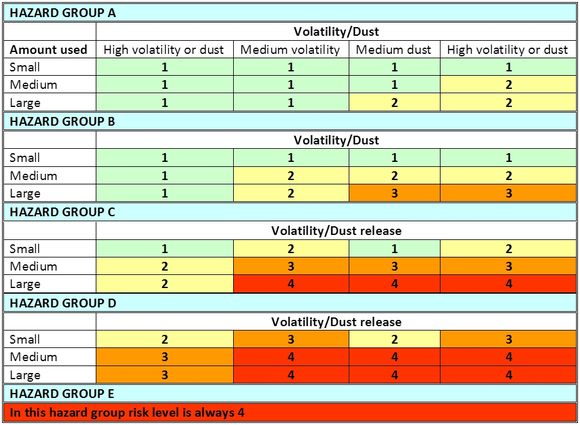1. Elaborated by
UK Health and Safety Executive
2. Description
COSHH Essentials is an assessment method developed by the UK Health and Safety Executive to help firms comply with the Control of Substances Hazardous to Health Regulations (COSHH).
The method is used to determine the appropriate control measures for a given task and not specifically to assess risk levels. However, it can be used to compare alternatives by determining hazard levels for different substances and products.
The method implements four hazard levels that depend on the intrinsic hazard, potential environmental exposure and amount of substance used.
Intrinsic hazard is expressed in 5 categories or levels (A, B, C, and D & E); depending on the H phrases on the products label and safety data sheet (see table 1). Hazards in terms of skin and external mucous membrane are also considered. Potential exposure is classified according to volatility of liquids and tendency to form dust in the case of solids. Using these three pieces of information, the expected risk level is established according to hazard groups, environmental tendency and amount of substance used.
Risk levels for COSHH Essentials
3. Reliability
Safety data sheets are an important source of information for this method. In various studies carried out across Europe, relevant deficits have been identified in safety data sheets, particularly for classification. Therefore, it may be advisable to check the classifications assigned to substances by using additional sources (e.g. ECHA substance database). However, the implementation of the European Chemicals Regulation (REACH) has improved the amount and quality of information for substances.
4. Applicability
Applicability is restricted to single cases of substitution of one product by another. It is not possible to compare products with alternative processes or technologies. The most important advantage of this method is that is very easy to handle by non-professional users and facilitates a quick assessment on possible substitutes and alternatives. It is applicable only to chemical hazards and risks.
5. User friendliness
The method is easy to use by non-professional users and does not require specific training if SDS are available. This method is mostly aimed at SME’s and non-specialized users.
6. Limitations
The method is based on the classification of substances. Classification is legally required for all substances that are placed on the market in the EU. However, from safety data sheets is often not obvious why a classification was NOT assigned (due to missing data or inconclusive data or due to data management that there is no danger?). In cases of doubt, classification should be cross-checked with other databases, e.g. ECHA substance database.
It does not take into account eco-toxicological properties, but only deals with risks to health.
The method is not suitable for policy decisions or use by chemical formulators or article manufacturers as it takes in account the exposure conditions of workplaces.
7. Availability
Free access to online format is available. The full method can be purchased from HSE. An abbreviated version useful for preliminary comparisons has been published in the practical guidelines for risk assessment of the European Commission.
